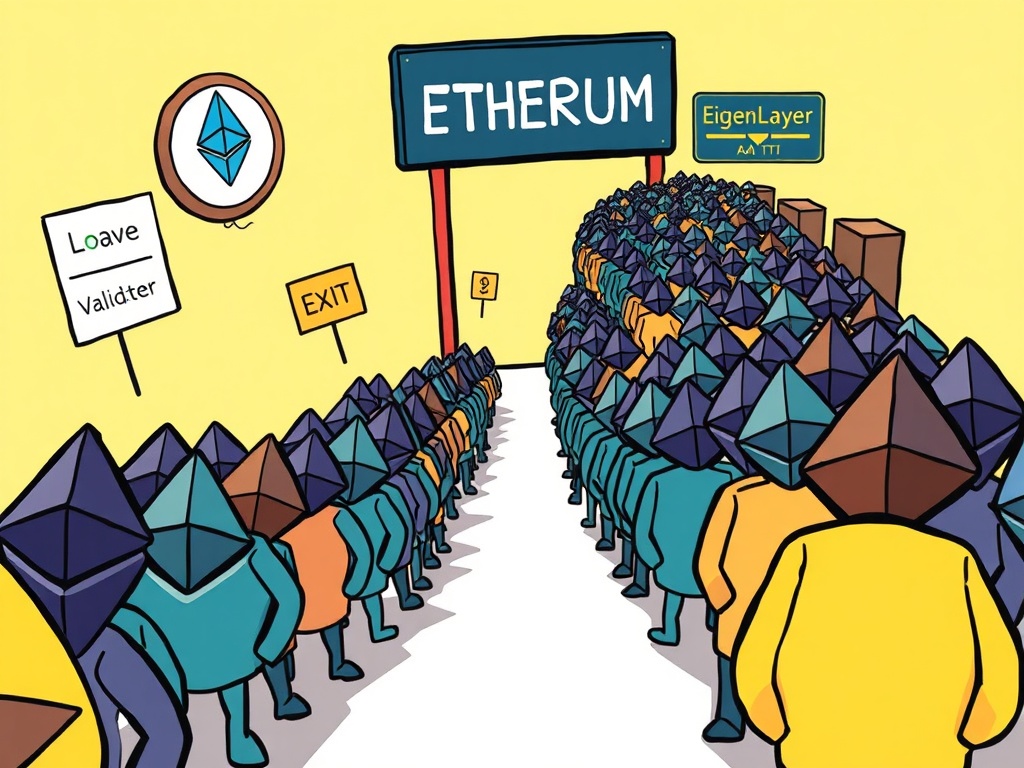BitcoinWorld

Ethereum Validator Queue: Unprecedented Surge and Its Market Implications
In the dynamic world of cryptocurrency, things can change at lightning speed. Recently, the Ethereum network experienced an unprecedented event that sent ripples through the staking community: the Ethereum validator exit queue surged to an all-time high. This wasn’t just a minor fluctuation; it was a dramatic spike from fewer than 1,000 daily exits to a staggering 744,000 in just two weeks, according to data from The Block. But what exactly caused this sudden exodus, and what does it mean for the future of Ethereum?
What Exactly Happened to the Ethereum Validator Queue?
To truly grasp the significance of this event, let’s first understand what an Ethereum validator is. Validators are crucial participants in Ethereum’s Proof-of-Stake (PoS) consensus mechanism. They stake 32 ETH to propose and attest to new blocks, ensuring the network’s security and integrity. In return, they earn rewards.
When a validator decides to stop participating, they enter an ‘exit queue.’ This queue manages the orderly withdrawal of staked ETH, preventing a sudden flood of unstaked assets that could destabilize the market. Typically, this queue moves slowly, with only a handful of validators exiting daily. However, the recent surge to 744,000 pending exits painted a very different picture. This wasn’t a sign of panic, but rather a coordinated response to specific market forces.
Here’s a quick look at the scale of the change:
- Before two weeks ago: Fewer than 1,000 validator exits daily.
- Recent peak: Over 744,000 validators in the exit queue.
- Implication: A significant portion of staked ETH (over 23 million ETH) was signaling an intention to withdraw.
This dramatic increase was primarily driven by a confluence of factors, specifically a liquidity shock on Aave and strategic moves related to EigenLayer.
The Aave Effect: How Borrowing Rates Fueled the Ethereum Validator Exodus
One of the primary catalysts for the surge in the Ethereum validator exit queue was the unexpected spike in wETH (wrapped Ethereum) borrowing rates on Aave, a leading decentralized finance (DeFi) lending protocol. Many large ETH holders engage in what’s known as ‘leveraged staking’ or ‘liquid staking’ strategies. This often involves:
- Staking ETH to receive liquid staking tokens (LSTs) like Lido’s stETH.
- Depositing these LSTs as collateral on platforms like Aave to borrow more wETH.
- Using the borrowed wETH to buy more ETH, stake it, and repeat the cycle, amplifying staking rewards.
This strategy works well when borrowing costs are low and staking rewards are stable. However, when wETH borrowing rates on Aave soared, these leveraged positions became incredibly expensive to maintain. The cost of borrowing began to outweigh the staking rewards, putting these holders in a precarious financial situation. To avoid potential liquidations and minimize losses, many were forced to unwind their positions. Unwinding these positions often meant exiting their Ethereum validator stakes to free up the underlying ETH.
Consider this simplified example:
| Strategy Phase | Action | Impact on Staker |
|---|---|---|
| Initial Setup | Stake ETH, get stETH, deposit stETH on Aave, borrow wETH. | Leveraged exposure to ETH staking rewards. |
| Rate Spike | Aave wETH borrowing rates surge. | Cost of borrowing exceeds staking rewards; strategy becomes unprofitable/risky. |
| Forced Unwind | Exit Ethereum validator, unstake ETH, repay wETH loan. | Reduces exposure to high borrowing costs, but removes validator from network. |
This dynamic created a cascade effect, with a significant number of large stakers simultaneously deciding to exit, pushing the queue to its record high.
EigenLayer’s Role: A New Chapter for Ethereum Validators?
While Aave’s liquidity shock was a major driver, another significant factor contributing to the surge was the reopening of EigenLayer’s deposit cap. EigenLayer is a groundbreaking restaking protocol built on Ethereum. It allows staked ETH (and LSTs) to be ‘restaked’ to secure other decentralized applications (dApps) and middleware, known as Actively Validated Services (AVSs), in exchange for additional rewards.
When EigenLayer reopened its deposit caps, it presented a lucrative opportunity for stakers and operators. Many saw the potential for higher yields by migrating their staked ETH from traditional validators to EigenLayer’s restaking mechanism. However, to participate in EigenLayer’s native restaking (which requires direct ETH deposits, not just LSTs), some operators needed to first exit their existing Ethereum validator positions. This strategic shift further fueled the increase in the exit queue, as operators optimized their capital allocation for new opportunities.
The combination of these two distinct but simultaneous events created the perfect storm for the unprecedented queue length. It wasn’t a single point of failure, but rather a reflection of the evolving DeFi landscape and strategic capital movements within the Ethereum ecosystem.
Unpacking the Implications: What Does This Mean for Ethereum Staking and Beyond?
An unprecedented surge in the Ethereum validator exit queue might sound alarming at first glance, but it’s crucial to understand the broader implications:
- Network Stability: Despite the large number of exits, the Ethereum network’s security and stability remained robust. The exit queue mechanism is designed precisely for this purpose – to manage withdrawals in an orderly fashion without disrupting consensus. New validators are also constantly joining, balancing the system.
- Market Dynamics: The forced unwinding of leveraged positions likely contributed to some selling pressure on ETH as users repaid loans. However, the overall market impact was contained, suggesting the ecosystem’s resilience. The fact that Aave rates are expected to normalize also indicates a temporary rather than structural issue.
- Staking Landscape Evolution: This event highlights the increasing sophistication of staking strategies and the interconnectedness of DeFi protocols. Stakers are constantly looking for optimal yield opportunities, and platforms like EigenLayer are changing the game by offering new layers of utility for staked ETH.
- Risk Management: For individual stakers and institutional players, this serves as a potent reminder of the risks associated with leveraged positions and the importance of understanding the underlying mechanics of DeFi protocols. Diversification and careful risk assessment remain paramount.
Looking Ahead: Will the Ethereum Validator Queue Normalize?
The good news is that the congestion in the Ethereum validator exit queue is widely expected to ease. As Aave’s wETH borrowing rates normalize, the pressure on leveraged stakers will diminish, reducing the incentive for further exits. Market dynamics are fluid, and rates tend to adjust based on supply and demand.
Furthermore, while EigenLayer’s cap reopening spurred some exits, it also represents a new frontier for ETH utility. As more participants explore restaking, the overall value proposition of holding and staking ETH could strengthen in the long run, attracting new capital to the network.
For those involved in Ethereum staking, this event underscores a few key actionable insights:
- Stay Informed: Keep a close eye on interest rates across major DeFi lending platforms.
- Understand Your Strategy: If you’re using leveraged staking, be fully aware of the liquidation risks and borrowing costs.
- Explore New Opportunities: Protocols like EigenLayer offer innovative ways to earn yield, but always do your due diligence.
In conclusion, the surge in the Ethereum validator exit queue was a significant, albeit temporary, phenomenon driven by specific market conditions and strategic shifts. It demonstrated the complex interplay between different DeFi protocols and the evolving landscape of Ethereum staking. Far from signaling a weakness, it highlighted the network’s robust mechanisms for managing large-scale capital movements and the continuous innovation within its ecosystem. As the dust settles, Ethereum continues to demonstrate its resilience and adaptability, paving the way for a more sophisticated and dynamic future for decentralized finance.
Frequently Asked Questions (FAQs)
Q1: What is an Ethereum validator?
An Ethereum validator is a participant in the Ethereum network who stakes 32 ETH to help secure the blockchain. They are responsible for proposing and attesting to new blocks of transactions, ensuring the integrity and security of the network in exchange for staking rewards.
Q2: Why did the Ethereum validator exit queue suddenly surge?
The surge was primarily caused by two factors: soaring wETH borrowing rates on Aave, which forced leveraged stakers to unwind their positions, and the reopening of EigenLayer’s deposit cap, which led some operators to exit existing validators to restake ETH for new opportunities.
Q3: Does a large exit queue mean Ethereum is in trouble?
No, a large exit queue does not mean Ethereum is in trouble. The exit queue is a built-in mechanism designed to manage withdrawals in an orderly manner, preventing sudden unstaking that could destabilize the network. It demonstrates the system’s ability to handle significant capital movements without compromising security or consensus.
Q4: What is leveraged staking and why is it risky?
Leveraged staking involves using staked ETH (or liquid staking tokens) as collateral to borrow more ETH, which is then restaked, amplifying potential rewards. It’s risky because if borrowing costs (interest rates) rise significantly, the cost of maintaining the loan can outweigh staking rewards, leading to potential losses or forced unwinding of positions.
Q5: How does EigenLayer relate to Ethereum validators?
EigenLayer is a restaking protocol that allows staked ETH to be re-purposed to secure other decentralized applications (AVSs) for additional rewards. Some existing Ethereum validators may choose to exit their traditional validator roles to participate in EigenLayer’s native restaking, which offers new yield opportunities.
Q6: Will the validator exit queue remain high?
The congestion in the validator exit queue is expected to ease as Aave’s wETH borrowing rates normalize. The underlying market forces that drove the surge are likely temporary, and the system is designed to self-correct over time.
If you found this article insightful, please consider sharing it with your network on social media! Your support helps us continue to provide valuable insights into the crypto world.
To learn more about the latest Ethereum trends, explore our article on key developments shaping Ethereum staking dynamics.
This post Ethereum Validator Queue: Unprecedented Surge and Its Market Implications first appeared on BitcoinWorld and is written by Editorial Team





